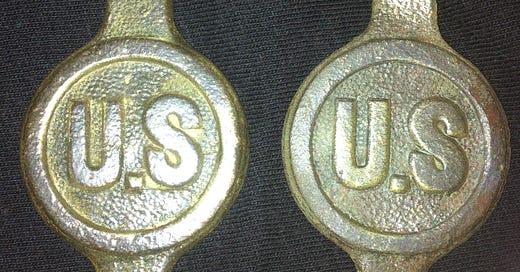I have a cousin who owns a fairly large farm nearby and he explained that a certain field used to have a tenant house back in the 1850’s. The house has been gone for some time because there were only a few bricks scattered throughout the field—there was no sign of the actual house at all. Just before the Confederates burned Chambersburg in July of 1864 a group of Confederates came to the farm looking for horses and supplies. Because it was known that they were in the area commandeering these things, Joe’s ancestor had hidden the horses and supplies and passed himself off as a poor farmer with nothing worth stealing. As far as Joe knows, there were no Union troops in the area, but the bit bosses are definitely Union issue. My speculation is that perhaps after the War there may have been a selling off of Union surplus, and that’s how these bosses were acquired. It’s also possible that a Union soldier passing through suffered a broken bridle, which was discarded along the way home from the war. It would be nice to find the bit that the bosses adorned, but that may never happen. Whatever happened, it’s a cool find, and I love the history behind the finds. I framed one of the bosses and gave to Joe as thanks for letting me detect his fields. (Below is a photo showing the bosses as they would have been attached to the bit.)
Another early find about two weeks later was a license badge that I found at an uninhabited farm nearby. According to Wikipedia Pennsylvania drivers were required to supply their own license plates between 1903 and 1905, but the lack of uniformity led the state to begin issuing standardized plates in 1906. Between 1906 and 1909 the license plates actually indicated that the driver, not the vehicle, was licensed. These early plates were made from porcelain-coated iron. In 1910 the state began issuing badges with an inscribed “Maker’s Number”, which were riveted to the plate, indicating that the plate was assigned to the vehicle, not the driver. These maker’s numbers were the early equivalent of the VIN (Vehicle Identification Number) which all automobiles carry on a plate inside the driver’s door, as well as other places.
Beginning in 1916 the plates were made from embossed steel, and from 1916 to 1919 these numbers were inscribed directly onto the embossed keystone on the plates, rather than on a riveted badge, so this particular badge (above) was issued between 1910 and 1915. In 1920 Pennsylvania ceased inscribing the Maker’s Number/VIN on the plate.
It would be nice to know how to research the number on this one and find out the year, make, and model of the vehicle that it came from. If anybody knows how to do this, please let me know.








So cool! Great post, thanks for sharing!